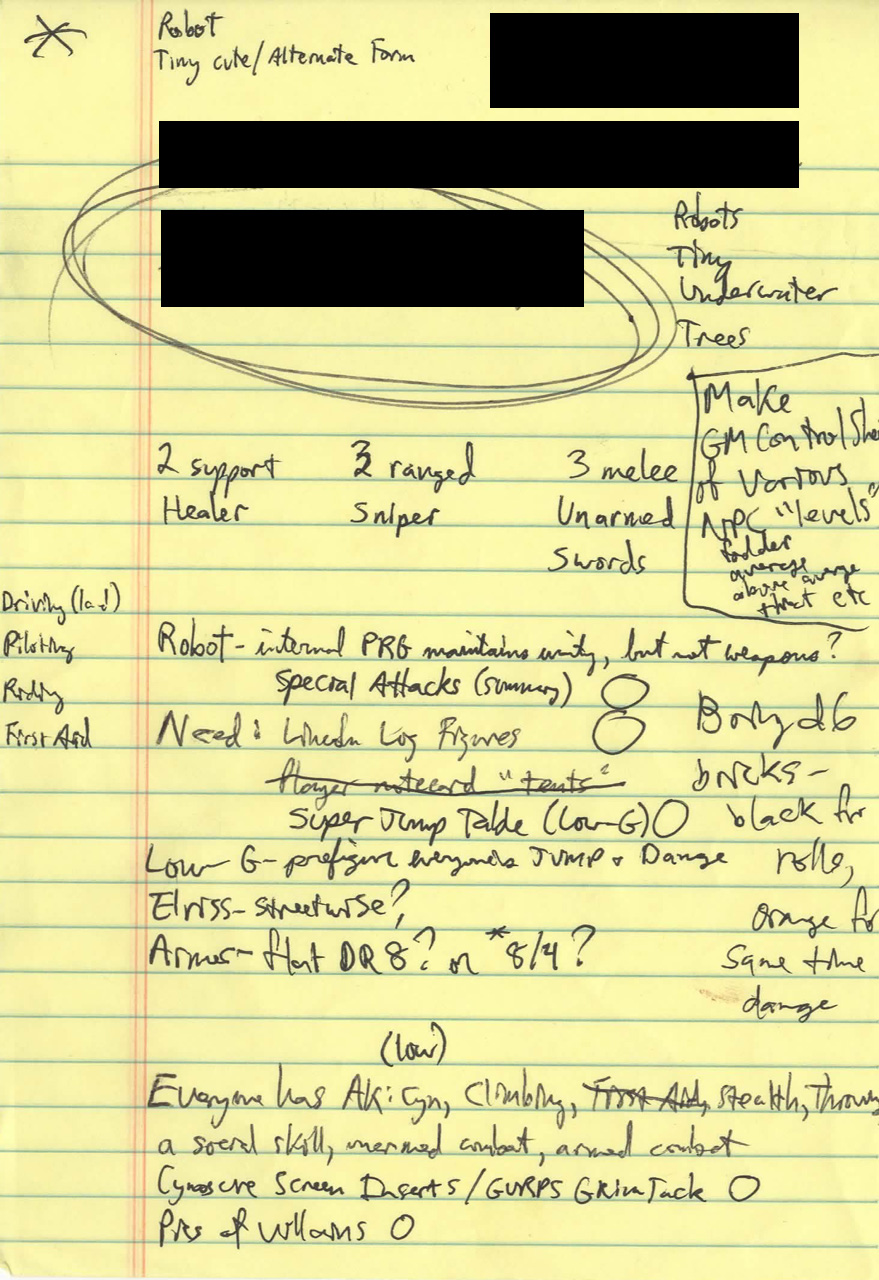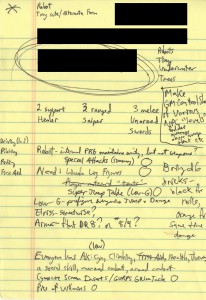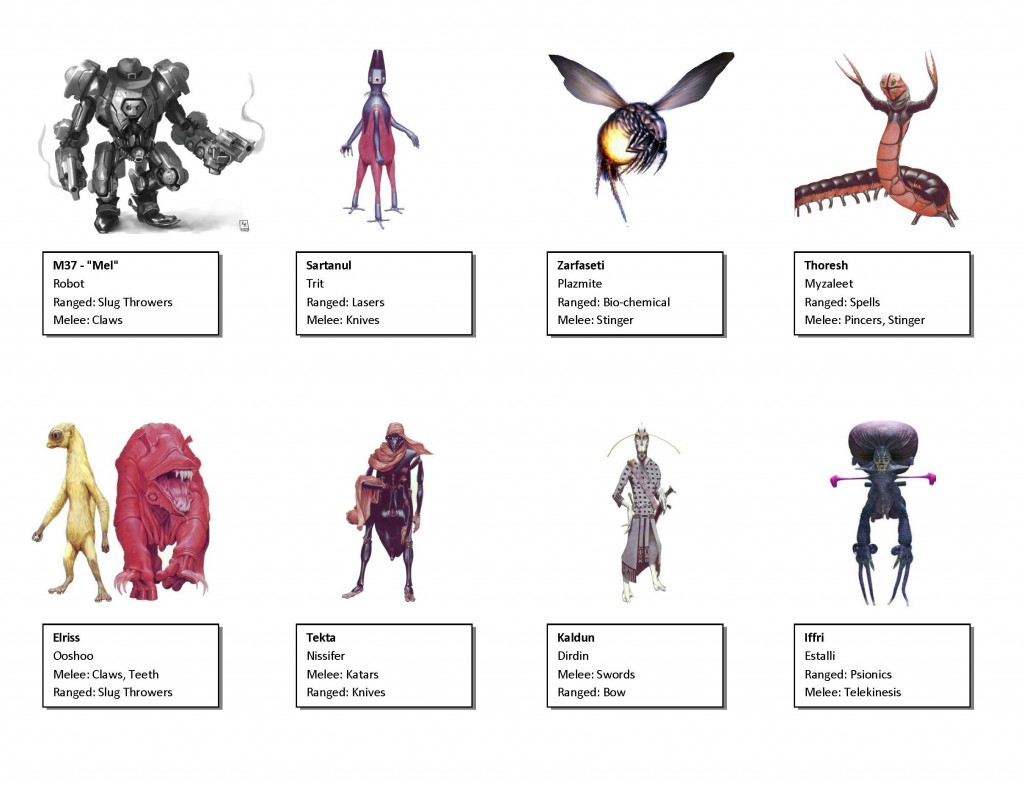
Probably the most common question any GM is asked, behind “Do you do it for the money, the prestige, or the groupies?”, is “How do you create your adventures?”
In these posts I’ll be dissecting a recent convention game I ran, step-by-step and start to finish, to give everyone a peek behind my GM screen. It should go without saying that this is the way I prep my games — it is not intended to be The One True Way, because the entire philosophy of GURPS is “Here are the tools, play however you want to.”
Still, I hope some folks find it helpful.
Step 0 – Perpetual Prep
This is the step before the steps. Just like writers of more traditional forms, I always have something on hand to record ideas: moleskine, voice recorder app on my phone, unpaid intern, something. I never, ever let an idea slip away if I can help it — a setting, a plot, a character, a mannerism, an image, a turn of phrase — doesn’t matter, they all get recorded and ultimately find their way to my omnivorous OneNote File of Stuff for later use.
While I do agree with authors like Stephen King that ideas are commonplace, that our brain tosses them out like confetti, they are worthless to me if I don’t record them. I will not remember them on my own, no matter how brilliant I think they are in the moment! I don’t know if everyone is like this or if it’s just me, but my advice is — record it. Then when the time does come to run your next game you can simply wade through your, say, “Villains” file and pick the best fit from all the ones you’ve ever dreamed up.
Step 1 – What Is It?
This is sort of the “glimmer in your eye” stage. One day, sometime before OrcCon 2013, I wasn’t planning to run a game; the next day, I was. For Step 1, I figure out what the game is going to “be,” in the very broadest sense, just a one- or two-sentence summary.
Do you want to run a “Cthulhu game where the PCs battle monsters in Chicago”? A “spy game set during the Cold War”? Maybe a “game where the PCs are ferrets”?
In the case of my convention game, I knew I wanted to run a “GrimJack game set in Cynosure.” Whee, Step 1 done!
Step 2 – What Happens?
In Step 2 I give the game a little bit of shape. There are a gajillion stories that can be told in Cynosure — but only one will fit in a four-hour convention game. And those hours go by in a blink.
I knew I wanted to have GrimJack at least present in the story, but I didn’t want him to be active in the story and overshadow the PCs with all of his badassery™. I also wanted all of the characters to know one another to keep the special snowflakes from wandering off. So I flipped through a few GrimJack comic books, brainstormed for a while, and eventually decided the game should be about GrimJack being kidnapped and (hopefully) rescued by a group of six of the regular patrons of Munden’s, the bar he owns. Good enough — Step 2 done!
Step 3 – The Player Characters
To my mind, this is probably the most important step, whether I’m creating pre-gens for a convention game or helping a group of players mesh together a solid group of characters that can all work well together. To me, the “story” is secondary — great characters can be fun to play in even the weakest of stories, but weak characters can’t save the most brilliant of games.
Setting a game in Cynosure has its own unique challenges. The city is the absolute perfect showcase for GURPS’ strengths and variety because it is the very definition of a kitchen sink, anything goes kind of setting. But that also means I as GM need to take into account low-tech weapons, high-tech weapons, even ultra-tech weapons (lasers and such), as well as magic, psionics, a dizzying array of species and races, and the fluctuating chaos of the dimensions themselves.
For the first time in the process I set pen to paper.

Apart from the completely-unrelated parts I redacted (this was the top page of my doodle pad), I’ll translate my chicken scratches for those not fluent in “third-grade handwriting.”
“Robot, Tiny cute/Alternate Form”
I quickly decided I wanted a robot and a cute little critter that could “Hulk out” as PCs. Both of these characters made it to the final cut.
“Robots, Tiny, Underwater, Trees”
These were ideas for dimensions, not characters. Dimensions populated solely by robots, or tiny creatures, etc. to maybe use in the game.
“2 Support (Healer), 3 Ranged (Sniper), 3 Melee (Unarmed, Swords)”
I knew I wanted to make 8 pre-gens for the 6-player game, so I broke them down into three broad groups, to make sure the party choices would be covered for the most common challenges. These would be their primary niche, but I was careful to not make anyone completely ineffective outside their sphere.
- Both Support PCs ended up being healers, one with magic and one with psionics, but they each still had plenty of attack capability
- The three Ranged PCs all had secondary skills for melee combat (I ended up not making a sniper, since they often go off on their own to find good vantage points and cover the team from afar — good tactically, but slows things down game-wise)
- The three Melee PCs all had secondary skills for ranged combat (ended up with PCs using swords, katars, and claws — one of the Ranged PCs ended up being a great wrestler, but unarmed melee wasn’t his focus).
Bunch of things I “Need”
These are all the notes with circles near them (the theory being I would check off the circle when it’s completed).
- Special Atttacks (Summary): I did make this, just a reminder list of who attacks with what.
- Lincoln Log Figures: I used these in my Jem game, but for this one chose trifold paper minis instead (we’ll get to those later).
- Super Jump Table: It would have been useful to pre-figure all characters’ Jump values while in a lower-G dimension — but I didn’t end up using that dimension so it didn’t matter.
- Bring d6 bricks — black for rolls, orange for same time damage: Yep, did this, but all players had their own dice anyway, and no one rolled damage at the same time (you can speed up GURPS combat a bit by rolling 6d6 [two different-colored groups] instead of 3d6, though it seems most players prefer not to do that).
- Cynosure Screen Inserts / GURPS GrimJack: Made both of these as well.
- Pics of Villains: This I didn’t do, though it was purely because I ran out of prep time. No one seemed to mind.
“Universal” Skills
And finally, skills that all the pre-gens have, regardless of their primary role (even if it’s just at default). This is a pared down list from a most excellent post by Kromm, the GURPS Line Editor.
- Area Knowledge (Cynosure) — I used this pretty cinematically, as a kind of catch-all skill for determining what the character knew about a given race or dimension (and so made it a Very Hard skill)
- A Social skill (more correctly, Influence skills: one of Diplomacy, Fast-Talk, Intimidation, Savoir-Faire, Sex Appeal, Streetwise)
- An Unarmed combat skill (one of Boxing, Brawling, Judo, Karate, Sumo Wrestling, Wrestling)
- An Armed combat skill (obvious: bows, guns, frying pans, etc.)
- Climbing
- Driving/Riding/Piloting
- First Aid
- Stealth
- Throwing
I also had a second piece of paper with a list of traits I thought might be interesting to use — and I didn’t use a single one except for Extra Arms. The others were Duplication, Gadgeteer, Insubstantial, Jumper, Modular Abilities, Possession, Snatcher.
So at this point I basically had a single small page with a few notes, and some rough ideas about the characters.
Next I delved into one of my image folders (from Step 0!) of non-human races and picked out 8 that I thought would make interesting characters:

I gave them each a name, race, and primary/secondary attack (based on my above party breakdown and their picture).
- Ranged: Mel (slug throwers), Sartanul (lasers), Zarfaseti (bio-chemical acid)
- Melee: Elriss (claws), Tekta (katars), Kaldun (sword and shield)
- Support: Thoresh (mage), Iffri (psionicist)
At this point I also jotted down some notes regarding obvious GURPS traits they would need — Machine for Mel (who later became Tex), Flight for Zarfaseti and Iffri, Extra Arm(s) for Sartanul and Tekta, etc.
Satisfied with the results of my afternoon’s work as being a good beginning, I packed up and called it a day.
There’s a great book on GM game prep called “Never Unprepared” which suggests that it’s better to do prepping in small doses and give time in between to let your mind mull things over. I’ve noticed the benefit of doing this for years, but never pursued it actively until that book pointed it out — now I try to do it on purpose instead of just randomly falling into it, and giving my brain a full day or two to slowly chew on things before coming back to it is a huge help!
Since this is where I first stopped the prep, and this post is already super long, I think I’ll break here. I’d love to hear what you think so far — things I didn’t mention you’re curious about, things I did mention that are a waste of space, whatever.
See you for Part 2!
Definitely the groupies. The slavishly dedicated throng of ladies that all look like they come from Game of Thrones central casting. Oh, yeah.
Oh, and adventures are fun too.
Only you get the big paycheck and the groupies. The rest of us shlubs have to settle for the occasional “good game” as the players run off to fight through the Subway backlog or to their next game.
Like you I keep something to scribble down ideas in with me at all times. I call it a journey book and for these I like to use bound sketch books because they have nice paper and I can draw in them so sketches for things and maps and such tend to appear as well. Ideas I like or make it into the actual material for the game gets transferred to OneNote where I do the actual work of prepping for a game.
Awesome stuff Mook looking forward to hearing the rest.
JiB
I love this write up Mook!
Flashes GURPS gang sign.